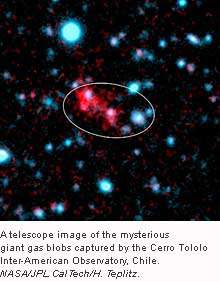New view of secret space blobs

Most objects in space have been catalogued, numbered and named, but one type of mysterious object has yet to be classified — and they are known simply as ‘blobs’.
Blobs are enormous clouds of intensely glowing gas, floating deep in space. Until now, astronomers thought that these gas clouds were empty — with nothing solid inside them. They were baffled at how such enormous gas clouds could exist, and glow so brightly, without having some power source within them.
A group of scientists including ANU astrophysicist Dr Paul Francis has today released new evidence about the blobs. They used NASA’s powerful new Spitzer Space Telescope to reveal that the blobs, far from being empty gas clouds, actually contain colliding groups of some of the brightest and most violent galaxies in the universe.
"With normal telescopes, these gas clouds look empty,” said Dr Francis. “But Spitzer uses infra-red light to penetrate the obscuring clouds of interstellar dust and reveal the hidden galaxies within. They are whoppers — each blob seems to contain two or three massive colliding galaxies, each of which is as bright as 10 trillion suns!”
Blobs are made up of hot hydrogen gas and are the biggest gas clouds in the known universe, being about 100 million times as large as a typical galaxy. Astronomers first noticed the glowing phenomena 10 years ago, but have not yet worked out where the gas comes from or what provides the energy to light them up.
“It now seems that most blobs contain massive colliding galaxies,” said Dr Harry Teplitz, from NASA’s Spitzer Science Center. “The collisions seem to be turning these galaxies into immense stellar nurseries — they are forming about one new star every single day. We would expect some of these new stars to explode — the blast waves from these stars could be producing the blobs. But we’ll need more observations to be sure.”
"Far from solving the mystery of the blobs, these observations only deepen it. Not only are the gas clouds bizarre, we now know that they contain some of the brightest and most violent galaxies in the universe," Dr Francis said.
These blobs lie at a distance of 10.8 billion light-years from Earth and were first discovered by Dr Francis using a combination of the Anglo-Australian Telescope, located at Siding Spring Observatory in New South Wales, and the Blanco Telescope, located at Cerro Tololo Interamerican Observatory, in Chile.
The research team includes Dr James Colbert from the California Institute of Technology; Dr Povilas Palunas, from the University of Texas; Dr Gerard Williger, from Johns Hopkins University; and Dr Bruce E. Woodgate, from NASA's Goddard Space Flight Center.
NASA's Jet Propulsion Laboratory, in Pasadena, California, manages the Spitzer Space Telescope mission for NASA's Science Mission Directorate, in Washington, D.C. Science operations are conducted at the Spitzer Science Center.
Source: Australian National University

















